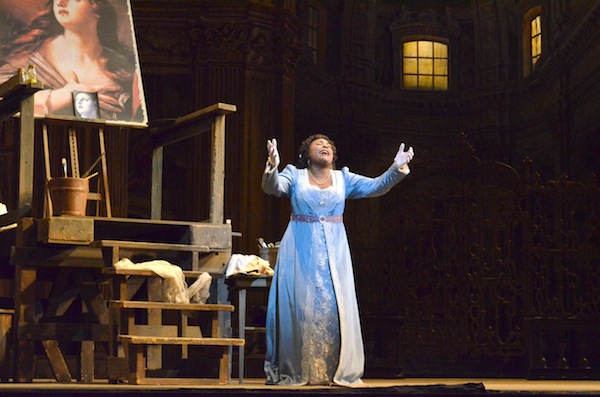
Two Florias, two Marios and one Scarpia: Who wins in Puccini’s Tosca?
By Sebastian Spreng, Visual Artist and Classical Music Writer
In an already historic 1983 video, famous baritone Robert “Scarpia” Merrill interviews 15 legendary Toscas. Each soprano discusses her experience as Sardou’s La Tosca in the operatic version á la Puccini, a role that would seem to fit them perfectly. Mixing life and art, between anecdotes and sighs, the divas advise fellow sopranos on the joys and risks of playing the unlucky heroine. As the essence of Tosca is the essence of the diva, the advice is all-valid. But, in a sardonic blow to the soprano’s ego, Puccini assigned the opera’s two great arias – Recondita armonia and E lucevan le stelle – to the tenor; then, added Vissi d’arte, perhaps the most ill timed aria in operatic history, to give her the golden opportunity to show off. The truth is that in Tosca what the tenor gets on a silver platter, the soprano has to earn for herself. Not only does she have to work the hardest onstage; her character also endures the most misfortunes, including, of course, death. In the women’s accounts, non-scripted mishaps also abound, from one’s wig catching fire to bouncing back up after the suicidal leap, to having to stab Scarpia with a fork for want of a knife, to Mario being actually wounded in the not-so-simulated execution.
Fortunately, none of that happened during the Florida Grand Opera’s third production of the season, a very conventional Tosca whose main virtue lay in the musical department. First, there was justified expectation for the work of two very different sopranos performing each series and approaching the role from two very different perspectives: that of experience and that of its opposite.
It’s easy to see that Kara Shay Thomson has sung the role more than a hundred times in U.S. venues. The American soprano translated her experience into a skillful management of resources – she conserved energy to deliver a first-rate Vissi d’arte – and her powerful, brilliant voice – that of a great Donna Anna in the making – made for a well-rounded portrayal. At the other extreme as to experience, Haitian-New Yorker Jouvanca Jean-Baptiste was an excellent surprise. She captivated the audience with her spontaneous and refreshing Tosca, expertly rendered despite the risks for a voice of exquisite silkiness. A new member of the FGO’s Young Artists Program, Jean-Baptiste’s performance has aroused well-deserved interest in her artistic development.
The two impressive tenors did not lag far behind. Puerto Rican Rafael Dávila, who boasts a generous voice of powerful timbre, and Mexican Diego Torre, who takes a more stylistic approach and possesses a timbre of rare beauty, played effective partenaires to their respective Florias. In contrast, one Scarpia sufficed for all performances: Todd Thomas, who combines menacing histrionics with a stentorian voice.
The rest of the cast delivered convincing performances, among them Adam Lau, another member of FGO’s young artists program, in the roles of Angelotti and Sciarrone. Lau’s development year after year bears noting. For his part, Jason Ferrante resorted to the macchietta to emphasize the personality of the detestable Spoletta.
Stage director José María Condemi made the most of ancient sets that evinced decades of use, endowing them with welcoming vitality. His achievement was noteworthy in the group scenes, as a result of which the first act – so often static or over elaborate – was enhanced by vivid touches. His lighting was also just right, a factor that contributed to the evening’s success. Michael Sakir deserves praise for the chorus’ good work in the Te Deum.
Too often audiences fail to notice that Tosca is not just a face-off among three voices in a crime drama that seems to support the assertion that opera plots boil down to “a tenor and a soprano want to make love, but are prevented from doing so by a baritone.” but a symphonic portrait of Rome, its sunrises, nights and dawns. The task of revealing the symphonic Puccini went to Ramón Tebar and his orchestra, which displayed a splendid palette of colors. The company’s musical director deserves double praise, as he “sang” with the orchestra and let the singers sing, supporting them admirably. It’s also important to note the progress the orchestra exhibits with every production – the fearsome entry of the brass and the risky phrasing of the cellos in the prelude to the third act providing irrefutable proof – a progress so remarkable that it competed for the evening’s starring role, and at times was the clear winner.
Jouvanca Jean-Baptiste as Puccini’s Tosca in Florida Grand Opera – Photo Justin Namon – Courtesy FGO
Recent Content
-
Artsarticle ·
-
Artsarticle ·
-
Artsarticle ·

